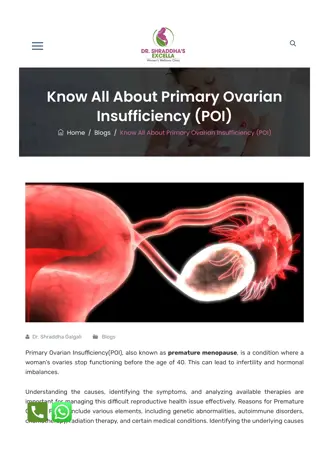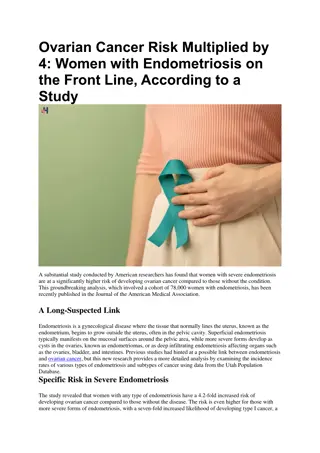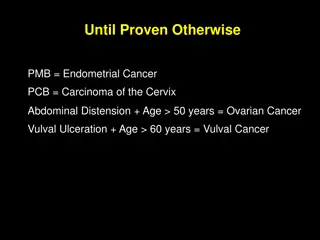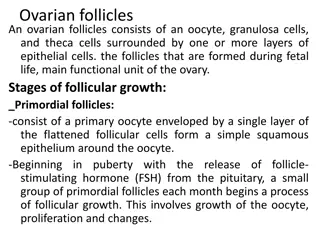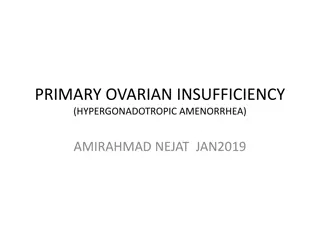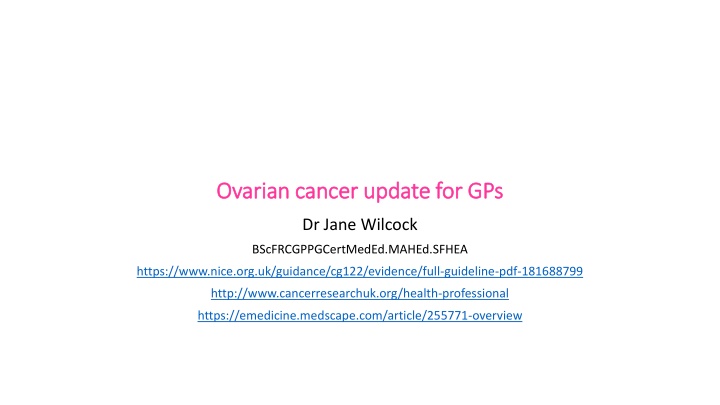
Update on Ovarian Cancer for GPs by Dr. Jane Wilcock
Ovarian cancer update including statistics, risk factors, screening recommendations, and new treatment options. Insights for GPs to better understand and manage this condition.
Download Presentation

Please find below an Image/Link to download the presentation.
The content on the website is provided AS IS for your information and personal use only. It may not be sold, licensed, or shared on other websites without obtaining consent from the author. If you encounter any issues during the download, it is possible that the publisher has removed the file from their server.
You are allowed to download the files provided on this website for personal or commercial use, subject to the condition that they are used lawfully. All files are the property of their respective owners.
The content on the website is provided AS IS for your information and personal use only. It may not be sold, licensed, or shared on other websites without obtaining consent from the author.
E N D
Presentation Transcript
Ovarian cancer update for GPs Ovarian cancer update for GPs Dr Jane Wilcock BScFRCGPPGCertMedEd.MAHEd.SFHEA https://www.nice.org.uk/guidance/cg122/evidence/full-guideline-pdf-181688799 http://www.cancerresearchuk.org/health-professional https://emedicine.medscape.com/article/255771-overview
The Ten Most Common Cancers in Females, Numbers of New Cases, UK, The Ten Most Common Cancers in Females, Numbers of New Cases, UK, 2015 2015 This chart excludes non-melanoma skin cancer because of known under-reporting http://www.cancerresearchuk.org/health-professional/cancer-statistics/incidence/common-cancers- compared#heading-Two
Ovarian cancer (OC) stats (cancer Ovarian cancer (OC) stats (cancer researchUK researchUK and NICE) and NICE) 7,270 cases pa ( 20 women a day) are diagnosed with ovarian cancer (OC) 4,277 die pa Most women are diagnosed with advanced stage disease and this contributes to ovarian cancer having the lowest relative five year survival rate of all gynaecological cancers (2007). The five year survival rates for patients with ovarian cancer have increased dramatically from 20% in 1975 to 38.9% in 2006 Overall survival is 35% over 5 years+ 6thmost common cancer in F and 4% of F cancers In the last 10 years mortality has dropped 16% Incidence is highest in F 60-64yrs according NICE guidance F aged 15-39yrs: 90% survive 5+yrs Newer drugs being added on, not replacing treatment like bevacizumab (Avastin) If BRACA1 or 2 +ve: olparib and niraparib recently recommended in recurrence
Risk factors for OC Risk factors for OC Age over 65yrs ( >50%cases) BRACA 1 and 2 5-15% cases Breast cancer increases the risk by two, more if occurs<40yrs old HRT (1% cases in UK) Endometriosis Cigs (3%cases) Talc Protective factors COC/CHC Having children Breastfeeding Tubal sterilisation
Screening for OC: not Screening for OC: not recommended UKCTOCS. United Kingdom Collaborative Trial of Ovarian Cancer Screening. The final analysis of the impact of ovarian cancer screening on the mortality from the disease recommended Lancet vol 387; No.10022;, p945 956, 5 March 2016 202,638postmenopausal women; 50 74 years from 13 centres in NHS Trusts in England, Wales, and N. Ireland. Excluded if BSO or known OC, FH OC, active non-OC malignancy. Random allocation to annual multimodal screening (MMS) with serum CA125 interpreted with ovarian cancer algorithm transvaginal ultrasound screening (USS) no screening, in a 1:1:2 ratio. The primary outcome was death due to ovarian cancer, comparing MMS and USS separately, with no screening. Median follow-up of 11 1 years. There were new OC diagnosis in 1,282 (0 6%) women: 338 (0 7%) in the MMS group 314 (0 6%) in the USS group 630 (0 6%) in the no screening group. BUT when prevalent cases were removed screening showed significantly different death rates with an overall average mortality reduction of 20%; reduction of 8% in years 0 7; reduction of 28% in years 7 14 in favour of MMS This is undergoing further follow up
Symptoms OC Symptoms OC F especially 50yrs with persistent or frequent (esp. > x12 times/month) persistent abdominal distension (bloating) feeling full and/or loss of appetite pelvic or abdominal pain increased urinary urgency and/or frequency New onset symptoms in last 12months of IBS as rarely presents for the first time at this age. In addition to NICE I would highlight PMB BrJGenPract 2013 Jan; 63(606): e11 e21. Symptoms and risk factors to identify women with suspected cancer in primary care: derivation and validation of an algorithm Hippisley-Cox J and Coupland C. PMB which gives a 88-fold increase in uterine cancer 29-fold increase in cervical cancer a 5-fold increase in ovarian cancer 4-fold increased risk of bladder cancer; 2-fold increase in breast cancer, blood cancer and other cancers
bloating feeling full and/or loss of appetite pelvic or abdominal pain increased urinary urgency and/or frequency New onset symptoms in last 12months of IBS PMB examination: abdo and PV for mass, ascites, bowel obstruction chest for pleural effusion Constipation Indigestion/reflux SOB Tired Weight loss
Investigations OC Investigations OC GP suspects OC refers 2WW GP cant detect obvious mass etc but patient has symptoms then undertake CA125 if<35iu reconsider diagnosis if>35iu undertake USS any abnormality on USS refer 2WW
Evidence for investigations in OC Evidence for investigations in OC Assume prevalence of OC with symptoms presenting to primary care of 0.23% If all women with symptoms were referred to secondary care around 1 in 500 referred would turn out to have ovarian cancer SO .. PPV of serum CA125 is 0.81% PPV USS 1.14% This means that around 1 in every 100 women referred to secondary care with positive serum CA125 or ultrasound would have ovarian cancer. NPV of CA125 is 99.94% NPV for USS is 99.96% This means 1 in every 2,000 women with negative tests would turn out to have ovarian cancer If women were only referred when both CA125 test and USS were positive, 3.67% would have OC = 1 in 26 referred would have ovarian cancer
Types of ovarian cancer Types of ovarian cancer 90% are epithelial cell OC and probably arise from end fallopian tubes 5% granulosa cell tumour (sex chord stromal tumour) can be non functioning or can produce oestrogen with irregular menses, PMB, breast tenderness 1% fallopian tube ca Teratoma ovary (germ cell ca of F in their 20s, dermoid tumour) Usually immature and benign esp. in younger ages Primary peritoneal ca PPC Borderline ovarian tumours (not cancer)
Treatments OC Treatments OC If v early stage1A may manage with ovary and fallopian tube removal Usually though TAH BSO with omentectomy and retroperitoneal LN sampling ollowed by CT using carboplatin and paclitaxel (Taxol) If advanced then bevacizumab is used usually CA125 can be used to follow up for recurrence with scans Thankyou for listening



